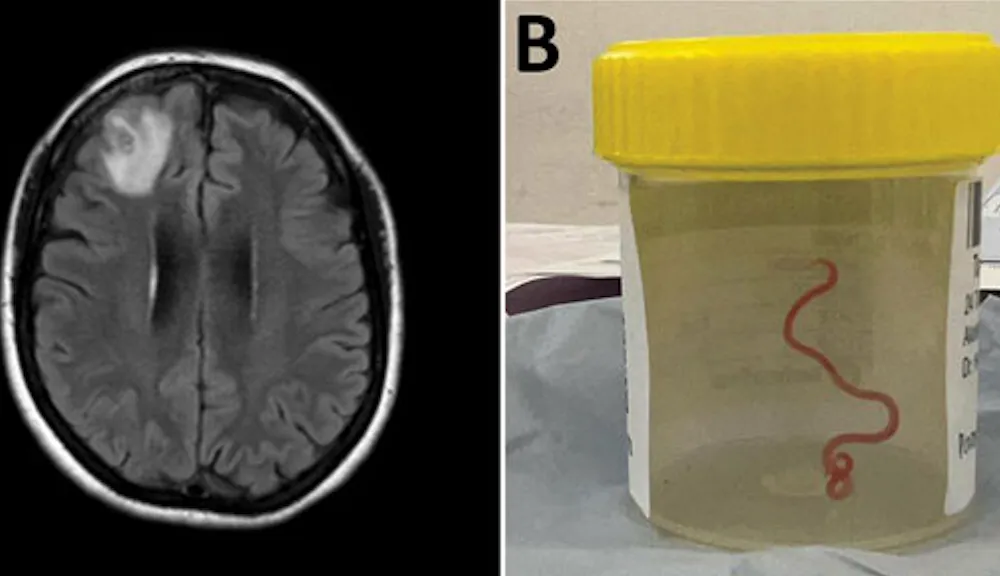Infection
Doctors Pulled a Wriggling, Three-Inch Worm From a Woman’s Brain
Doctors suspect the patient accidentally ingested the roundworm’s eggs while foraging for edible greens near her home.
Hossain et al. / Emerging Infectious Diseases
Doctors pulled a live, three-inch worm from a 64-year-old Australian woman’s brain last year, marking the first time the species has been found inside the brain of any mammal. The roundworm, Ophidascaris robertsi, normally infects snakes, so the discovery was quite a shock to the neurosurgeon who pulled the wriggling creature from the patient’s head.
Researchers described the details of this unprecedented case in a new paper published this month in the journal Emerging Infectious Diseases.
The creepy-crawly saga started in January 2021, when the woman began suffering from abdominal pain, diarrhea, night sweats and a dry cough, according to a statement from the Australian National University.
She went to a local hospital in New South Wales, Australia, where doctors drew blood and conducted body scans, reports Ars Technica’s Beth Mole. They learned she had some kind of infection, as well as lesions in her liver and spleen and pneumonia in her lungs. Tests for cancers, autoimmune diseases and parasites came back negative. So, they gave her a corticosteroid to treat the pneumonia and sent her on her way.
But less than a month later, she went to another hospital for a persistent cough and fever. Doctors noticed that she had high levels of eosinophils, a type of white blood cell that’s often found in patients with fungal and parasitic infections. Though her tests did not reveal human roundworm, physicians gave her ivermectin, an anti-parasitic drug, because of the possibility that her result was a false negative and because she had a history of traveling.
Then, last year, the woman began to feel forgetful and depressed. Doctors decided to conduct an MRI scan of her brain and spotted a growing lesion. When she went in for surgery in June 2022, neurosurgeon Hari Priya Bandi pulled out the worm with tweezer-like forceps.
Bandi was shocked by the discovery, which was not only unexpected, but also a bit outside her comfort zone.
“I’ve only come across worms using my not-so-good gardening skills,” she says to CNN’s Kathleen Magramo. “I find them terrifying, and this is not something I deal with at all.”
Watch: A parasitic roundworm was pulled out “alive and wriggling” from a woman’s brain in a world-first, #Australian doctors say.
The eight centimeter long #worm was discovered last year in a 64-year-old undergoing surgery in the Australian capital #Canberra. pic.twitter.com/L2Mgm5YpmV— Al Arabiya English (@AlArabiya_Eng) August 29, 2023
Recognizing the extreme rarity of the situation, Bandi immediately called other doctors for advice. She also sent the worm—which was still alive—to a scientist who specializes in parasites.
The scientist identified it as O. robertsi, a long, skinny roundworm with a reddish color that usually infects carpet pythons. The worms typically inhabit a snake’s stomach and esophagus, where they lay their eggs. When the snake defecates, it also sheds the eggs, which are then ingested by small mammals and marsupials. Inside those animals, the eggs mature into larvae. Then, when carpet pythons eat the small mammals, the larvae are transferred into the snake and complete their life cycle by growing into worms.
No human infection with any Ophidascaris species had ever been recorded until now. Doctors consider the woman to be an “accidental host” of the roundworm—she might have ingested some O. robertsi eggs by mistake while she was foraging for edible plants near her home.
“If the python’s pooed on that [plant] and there are eggs on that from the parasite, then it can get onto someone’s hands and they get ingested by that person accidentally,” says study co-author Sanjaya Senanayake, an infectious diseases expert at the Canberra Hospital and the Australian National University, to the Australian Broadcasting Corporation’s Nick Kilvert.
The woman was given more anti-parasitic drugs, and eventually, most of her symptoms improved. She is still being monitored by health professionals.
In hindsight, doctors now see that her symptoms matched the progression of a foodborne parasite, and that the corticosteroid may have actually allowed the roundworm to move through her central nervous system and ultimately into her brain, per Ars Technica.
However, the medical team did everything they could to solve the mystery with the information they had. Another patient may not have been as lucky.
“Sometimes, people die with the cause never being found,” says Peter Collignon, an infectious diseases expert at the Canberra Hospital and the Australian National University who was not involved in this case, to the Guardian’s Melissa Davey.
The overall risk of O. robertsi infections in humans is low—although, since the parasite and carpet pythons live in other parts of the world, other cases could emerge in the future, per the statement. However, more broadly, this case highlights the risk of infections passing from animals to humans, which are increasingly sharing the same habitats.
An estimated 75 percent of new human infections that have emerged around the globe within the last three decades have come from animals, including coronaviruses, according to the statement. As such, it’s critical that people who grow or forage food in areas where animals are present be extra diligent about washing their hands, their tools and the food itself.
As for the 64-year-old woman who went through this whole ordeal, she showed “patience and courage” throughout the entire process, Senanayake says in the statement.
“It is never easy or desirable to be the first patient in the world for anything,” he adds.
Recommended Videos

